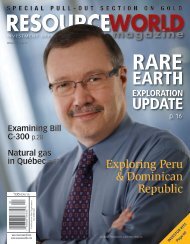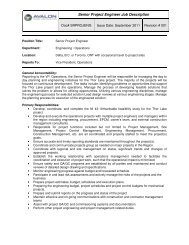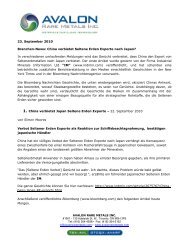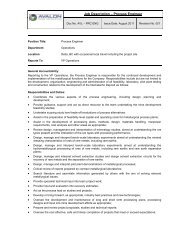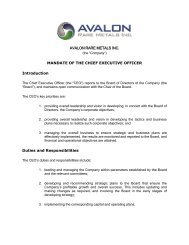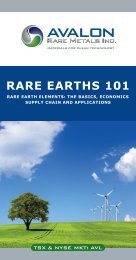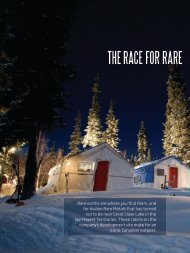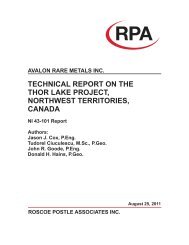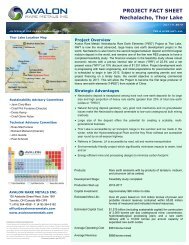technical report on the nechalacho deposit, thor lake project ...
technical report on the nechalacho deposit, thor lake project ...
technical report on the nechalacho deposit, thor lake project ...
Create successful ePaper yourself
Turn your PDF publications into a flip-book with our unique Google optimized e-Paper software.
8. DEPOSIT TYPES<br />
The mineral <strong>deposit</strong>s at Thor Lake site bear many of <strong>the</strong> attributes of an apogranite (Beus, et<br />
al., 1962) originating as an apical or domal facies of <strong>the</strong> parental syenite and granite. The<br />
<strong>deposit</strong>s are extensively metasomatized with pr<strong>on</strong>ounced magmatic layering and cyclic ore<br />
mineral <strong>deposit</strong>i<strong>on</strong>. The Nechalacho <strong>deposit</strong> essentially forms part of a layered, igneous,<br />
peralkaline intrusi<strong>on</strong>.<br />
According to Richards<strong>on</strong> and Birkett (1996) o<strong>the</strong>r comparable rare metal <strong>deposit</strong>s associated<br />
with peralkaline rocks include:<br />
• Strange Lake, Canada (zirc<strong>on</strong>, yttrium, beryllium, niobium, REE)<br />
• Mann, Canada (beryllium, niobium)<br />
• Illimausaq, Greenland (zirc<strong>on</strong>, yttrium, REE, niobium, uranium, beryllium)<br />
• Motzfeldt, Greenland (niobium, tantalum, zirc<strong>on</strong>)<br />
• Lovozero, Russia (niobium, zirc<strong>on</strong>, tantalum, REE)<br />
• Brockman, Australia (zirc<strong>on</strong>, yttrium, niobium, tantalum)<br />
Richards<strong>on</strong> and Birkett fur<strong>the</strong>r comment that some of <strong>the</strong> characteristics of this type of <strong>deposit</strong><br />
are:<br />
• Mineralizing processes are associated with peralkaline intrusi<strong>on</strong>s and <strong>the</strong> latter are<br />
generally specific phases of multiple-intrusi<strong>on</strong> complexes.<br />
• Elements of ec<strong>on</strong>omic interest include tantalum, zirc<strong>on</strong>, niobium, beryllium, uranium,<br />
<strong>thor</strong>ium, REE, and yttrium, comm<strong>on</strong>ly with more than <strong>on</strong>e of <strong>the</strong>se elements in a <strong>deposit</strong>.<br />
Volatiles such as fluorine and carb<strong>on</strong> dioxide (CO 2 ) are typically elevated.<br />
• End members may be magmatic or metasomatic although <strong>deposit</strong>s may show <strong>the</strong><br />
influence of both processes. Alterati<strong>on</strong> in magmatic types is often deuteric and local<br />
while alterati<strong>on</strong> in metasomatic types is generally more extensive.<br />
• This type of <strong>deposit</strong> is typically large but low grade. Grades for niobium, tantalum,<br />
beryllium, yttrium and REE are generally less than 1%, while <strong>the</strong> grade for zirc<strong>on</strong> is<br />
typically between 1% and 5%.<br />
• These <strong>deposit</strong>s display a variety of rare metal minerals including oxides, silicates,<br />
calcium phosphates and calcium fluoro-carb<strong>on</strong>ates. Niobium and tantalum<br />
mineralizati<strong>on</strong> is typically carried in pyrochlore and less comm<strong>on</strong>ly in columbite.<br />
The main chemical features of <strong>the</strong> Nechalacho <strong>deposit</strong> that c<strong>on</strong>trast to those overall features<br />
are that uranium is not particularly high with anomalous but modest levels of <strong>thor</strong>ium and <strong>the</strong><br />
lack of beryllium mineralizati<strong>on</strong>. Beryllium is present in <strong>the</strong> North T <strong>deposit</strong>, a separate smaller<br />
<strong>deposit</strong> to <strong>the</strong> north with dissimilar geology.<br />
Technical Report 43-101 – March 13, 2011 Page 8-1<br />
Prepared by Aval<strong>on</strong> Rare Metals Inc.





